Pasta! Almost everyone loves pasta, from Linguine with Clam Sauce to Spaghetti and Meatballs, from Pasta Primavera to Meat Lasagna. Pasta is a staple in the diets of many for its versatility, ability to fill our bellies, and its relative inexpensive nature. But do you really know how to cook, sauce and serve pasta properly? Preparing pasta dishes right actually isn't as simple as tossing dried noodles into a pot of boiling water.
I'll admit I may be a bit of a pasta snob. My heritage is (half-)Italian and I've traveled to Italy several times, where I've enjoyed some of the best pasta dishes of my lifetime. I'm also a passionate home cook and especially particular with how I prepare any pasta dishes. In this article, I'll address some of the common errors I've seen made in cooking pasta - don't worry, I've made a few of them in the past myself before knowing better! These mistakes are easy to correct and in no time you'll be "doing pasta right" - and pleasing your family and dinner guests with your pasta expertise.


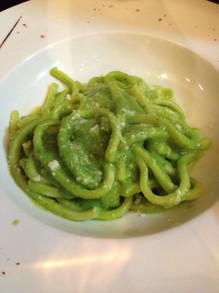
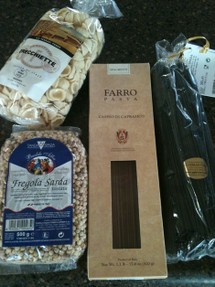 If you don't begin your recipes with the best ingredients, you can't expect the best results. The best dried pasta is made from
If you don't begin your recipes with the best ingredients, you can't expect the best results. The best dried pasta is made from 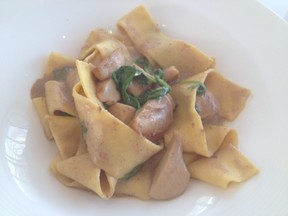 Pasta comes in many different shapes, cuts and styles for a reason far beyond appearance. Different shapes of pasta best suit different styles of cooking and different sauces. Thin, light and slippery sauces, like those made from white wine, olive oil and shellfish, do best with long noodles such as spaghetti, linguine or angel hair (for especially delicate sauces). Thick and chunky sauces like a Primavera or legume-based sauce do best with shapes such as shells, penne and farfalle. Pesto and other dense, herb-based sauces cling and make for hearty pairings with twisted, thick shapes such as Strozapretti. Experiment with different pasta shapes and find which ones work best with the sauces you regularly enjoy preparing. But don't simply grab whatever you've got handy in the cupboard; think about pairing your sauce with your pasta, just as you'd think about pairing a wine with your entree of choice.
Pasta comes in many different shapes, cuts and styles for a reason far beyond appearance. Different shapes of pasta best suit different styles of cooking and different sauces. Thin, light and slippery sauces, like those made from white wine, olive oil and shellfish, do best with long noodles such as spaghetti, linguine or angel hair (for especially delicate sauces). Thick and chunky sauces like a Primavera or legume-based sauce do best with shapes such as shells, penne and farfalle. Pesto and other dense, herb-based sauces cling and make for hearty pairings with twisted, thick shapes such as Strozapretti. Experiment with different pasta shapes and find which ones work best with the sauces you regularly enjoy preparing. But don't simply grab whatever you've got handy in the cupboard; think about pairing your sauce with your pasta, just as you'd think about pairing a wine with your entree of choice.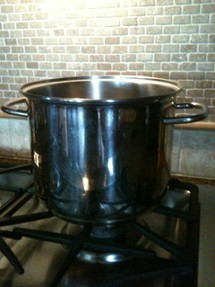 One common mistake I've seen in many kitchens is trying to cook too much pasta in too small of a pot. Pasta needs plenty of room to move around while cooking, and should be in a pot deep enough that the entire length of a noodle can be submerged in boiling water (by all that is holy, do not break long pasta noodles in half to fit them in a pot! That is just about sacrilege to any true pasta lover...)
One common mistake I've seen in many kitchens is trying to cook too much pasta in too small of a pot. Pasta needs plenty of room to move around while cooking, and should be in a pot deep enough that the entire length of a noodle can be submerged in boiling water (by all that is holy, do not break long pasta noodles in half to fit them in a pot! That is just about sacrilege to any true pasta lover...)


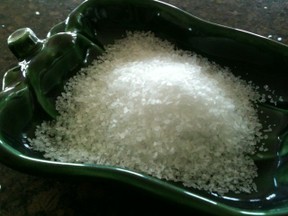 People are very conscious of salt consumption these days - perhaps far TOO conscious. Pasta water should always be salted, otherwise your final dish is sure to taste bland, no matter how spicy or rich a sauce you add to it. Additionally, if you add your salt only at the very end of cooking time, before serving, all you will taste is the salt because it hasn't had time to blend and merge with the other ingredients.
People are very conscious of salt consumption these days - perhaps far TOO conscious. Pasta water should always be salted, otherwise your final dish is sure to taste bland, no matter how spicy or rich a sauce you add to it. Additionally, if you add your salt only at the very end of cooking time, before serving, all you will taste is the salt because it hasn't had time to blend and merge with the other ingredients.
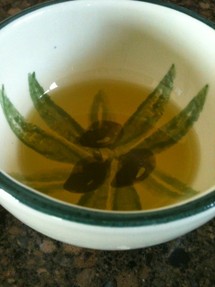 One of the biggest myths - and actual tragedies - of pasta cookery is the idea that you should add olive oil to your pasta cooking water. Absolutely not! People say adding olive oil keeps the pasta noodles from sticking to each other. That might be the case, but it also prevents the sauce from clinging to the noodles as it should when finally served!
One of the biggest myths - and actual tragedies - of pasta cookery is the idea that you should add olive oil to your pasta cooking water. Absolutely not! People say adding olive oil keeps the pasta noodles from sticking to each other. That might be the case, but it also prevents the sauce from clinging to the noodles as it should when finally served!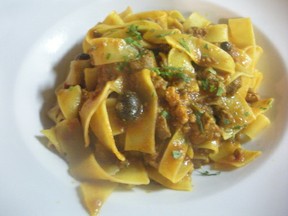 As mentioned above, the best way to make sure your pasta is not sticky and is well-mixed with your sauce is to do the mixing in the kitchen, before plating and serving. Don't just drop pasta onto serving plates and spoon sauce on top of it! Often the best thing to do is finish cooking your sauce on the stove top once the pasta noodles have been added, perhaps while just slightly "under"-done. This will ensure the sauce and noodles are well mixed, and that the seasoning of the sauce is correct because you'll have a chance to taste it in the kitchen before plating.
As mentioned above, the best way to make sure your pasta is not sticky and is well-mixed with your sauce is to do the mixing in the kitchen, before plating and serving. Don't just drop pasta onto serving plates and spoon sauce on top of it! Often the best thing to do is finish cooking your sauce on the stove top once the pasta noodles have been added, perhaps while just slightly "under"-done. This will ensure the sauce and noodles are well mixed, and that the seasoning of the sauce is correct because you'll have a chance to taste it in the kitchen before plating.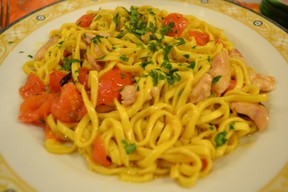 This problem is one I have with how many Italian-American restaurants choose to serve pasta in the United States. Pasta is meant to be combined with an appropriate amount of sauce, not swimming or drowning in it. The purpose of the sauce is not to drown out the flavor and texture of the pasta but to complement it. Dress the pasta in enough sauce to coat all noodles when tossed, but there should not be giant mounds of sauce sitting on top of the plate, or pooling around the pasta bowl edges. Worst yet is pasta turned into a congealed, solid mass from being combined with too much Alfredo or other style of cheesy cream sauce. Gross!
This problem is one I have with how many Italian-American restaurants choose to serve pasta in the United States. Pasta is meant to be combined with an appropriate amount of sauce, not swimming or drowning in it. The purpose of the sauce is not to drown out the flavor and texture of the pasta but to complement it. Dress the pasta in enough sauce to coat all noodles when tossed, but there should not be giant mounds of sauce sitting on top of the plate, or pooling around the pasta bowl edges. Worst yet is pasta turned into a congealed, solid mass from being combined with too much Alfredo or other style of cheesy cream sauce. Gross!


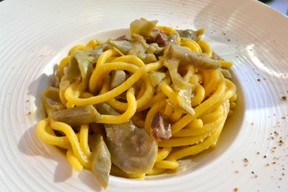 Pasta has earned a bad reputation in many diet plans, yet for centuries it has been a staple of the Mediterranean lifestyle. The thing to remember if you are health conscious is that Italians do not eat pasta to excess the way we tend to in the United States and other Western countries; pasta is served as a modest "first course" or side dish to a reasonable piece of meat or protein, not often a meal in and of itself.
Pasta has earned a bad reputation in many diet plans, yet for centuries it has been a staple of the Mediterranean lifestyle. The thing to remember if you are health conscious is that Italians do not eat pasta to excess the way we tend to in the United States and other Western countries; pasta is served as a modest "first course" or side dish to a reasonable piece of meat or protein, not often a meal in and of itself.




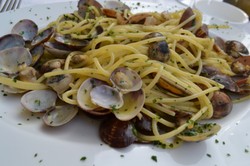

 A Potentially Fatal Accident in the Homeon 11/24/2018
A Potentially Fatal Accident in the Homeon 11/24/2018
 Windsurfing Lessons on Montserrat: One of My Funniest—and Fondest—Travel Memorieson 11/20/2018
Windsurfing Lessons on Montserrat: One of My Funniest—and Fondest—Travel Memorieson 11/20/2018
 Christmas Ornaments Celebrating Rome, Italyon 11/12/2018
Christmas Ornaments Celebrating Rome, Italyon 11/12/2018
 Philadelphia-Themed Christmas Ornamentson 11/09/2018
Philadelphia-Themed Christmas Ornamentson 11/09/2018

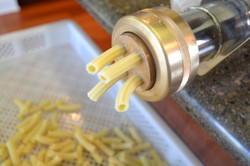
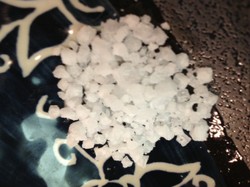
Comments
One thing I've done is blanch broccoli in the water I'm boiling to cook my pasta - that even adds some of the flavor to the water! But yes, broccoli makes a great and healthy base for a sauce, like a pesto, but with all of that extra nutrients.
Nice article. I wondered why you shouldn't add oil to boiling pasta. What you say makes sense. I also like your suggestion of broccoli paste. I often add broccoli to my pasta: steam it and then add it to the sauce. I will try broccoli paste too.